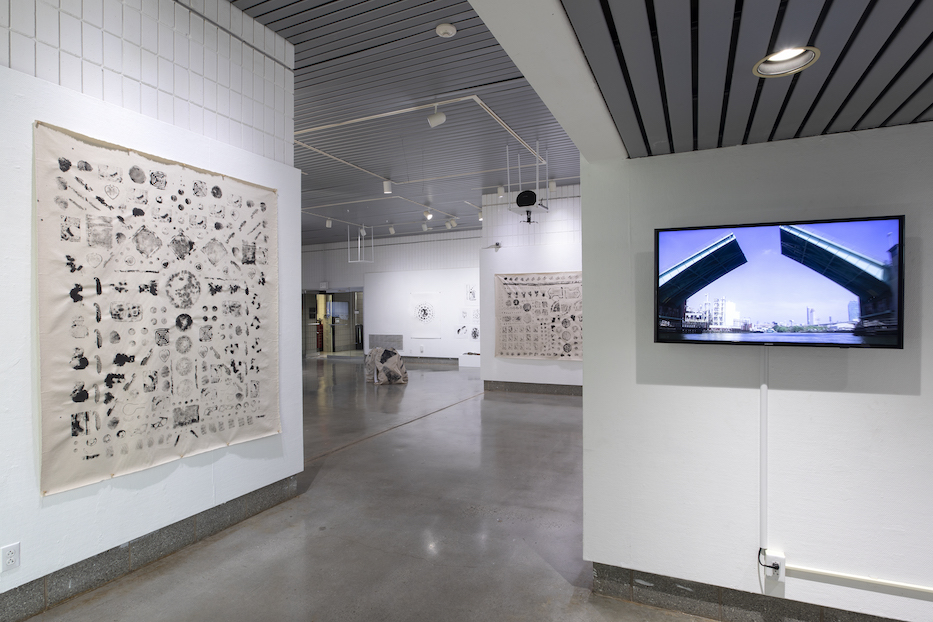
Culture & Community | Environment | Arts & Culture | Visual Arts | University of New Haven
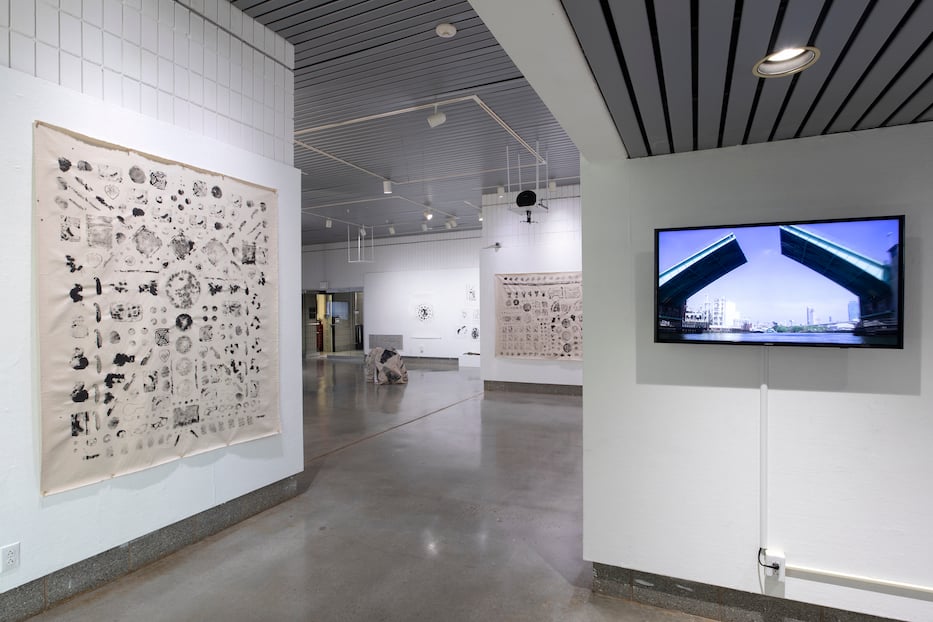
Installation view, To Dissolve into the Hydrocommons, One Drop at a Time. The exhibition, from New York based artist sTo Len, runs in the Seton Gallery at the at the University of New Haven through December 9. Photos by Jessica Smolinski courtesy of Seton Gallery.
The rhythmic roll of a tide scatters on sand like pop rocks on your tongue. A motorcycle’s engine crescendos in earshot, invisibly entering and exiting a tidal marsh. Car horns and gull caws inflect the whir of vulcanized rubber tires as they wear on pavement and meet metal grates. A hypnotic hum from mechanical systems and disembodied voices barely hold this cursive melody together.
New Haven Harbor and Interstate 95 are close by, but these competing sounds are generated indoors. A video, Sights and Sounds of Sites Along Long Island Sound (2022), streams between an eye-level screen and a speaker floating above visitors in the Seton Gallery at the University of New Haven (UNH).
To Dissolve into the Hydrocommons, One Drop at a Time, an exhibition by the New York-based artist sTo Len, documents his physical and aesthetic exploration of the Elm City’s waterways. It is on view through December 9. In the last year, sTo has also served as the artist in residence at New York City’s Department of Sanitation, a position that has existed since 1977.
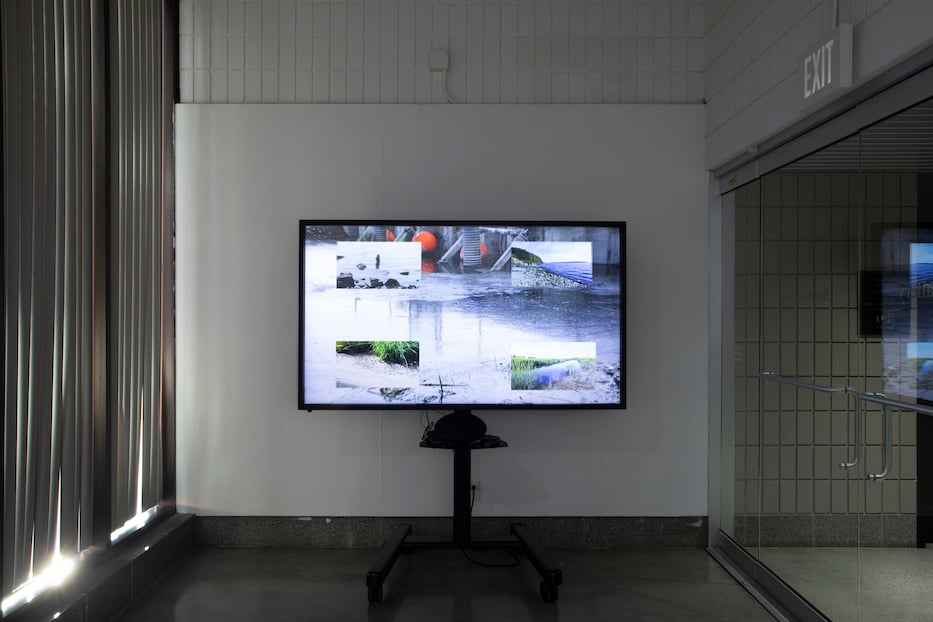 Installation view, To Dissolve into the Hydrocommons, One Drop at a Time. The exhibition, from New York based artist sTo Len, runs in the Seton Gallery at the at the University of New Haven through December 9. Photos by Jessica Smolinski courtesy of Seton Gallery.
Installation view, To Dissolve into the Hydrocommons, One Drop at a Time. The exhibition, from New York based artist sTo Len, runs in the Seton Gallery at the at the University of New Haven through December 9. Photos by Jessica Smolinski courtesy of Seton Gallery.
Complementing the soundscape of New Haven’s shore, sTo’s work blends the results of four trips, which included walkabouts skimming the edge of where water meets marsh and dryland. What Len depicts through moving images, printmaking, and photography reaffirms the area’s industrial legacy, which continues to operate in ways that clash with its natural state as well as municipal and state reclamation efforts.
As a Quinnipiac community, and after its incorporation by English colonists in 1638, New Haven’s inner and outer harbors have been a place of commerce. Centuries of alterations have shifted its coastal boundaries, which once began at Water Street, before significant infill accommodated even more intrusive commercial and transportation infrastructure still visible from the highway, harbor, rail line, and sky.
sTo makes a case that this marine environment is still in decay, though the closest active superfund site resides in the pastoral town of Durham a few miles northeast of the city. Even so, local waterways remain polluted by petroleum products, heavy metals, polychlorinated biphenyls (PCBs), and chlorinated solvents, which the artist adheres to paper through a Japanese marbling technique called suminagashi (floating ink).
Len dubs his process as tsunaminagashi, which compounds Japanese terms tsunami, for violent geological movements that create large waves with nagashi, for sink, which can be interpreted as absorbing carbon-containing chemicals.
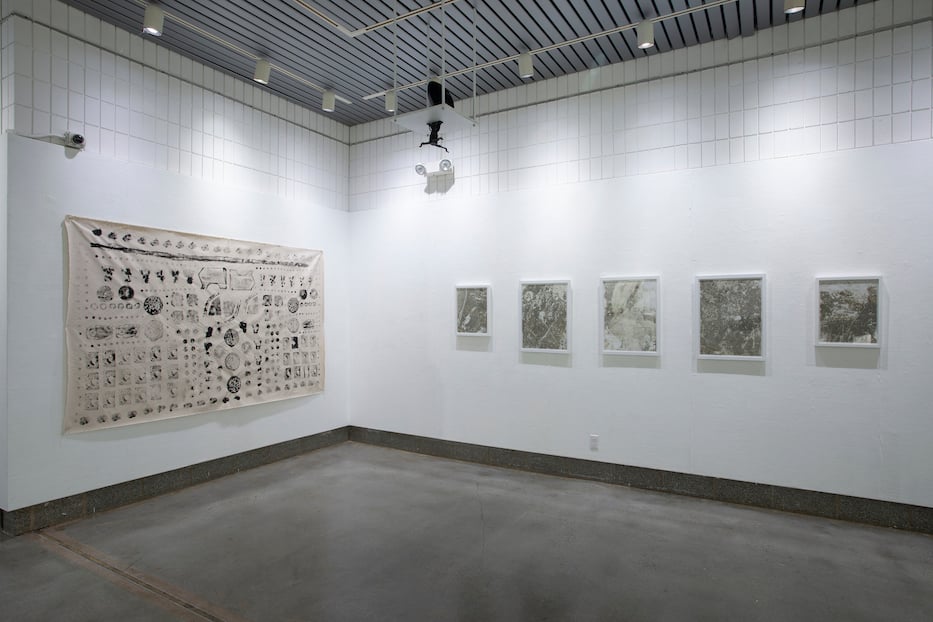 Installation view, To Dissolve into the Hydrocommons, One Drop at a Time. The exhibition, from New York based artist sTo Len, runs in the Seton Gallery at the at the University of New Haven through December 9. Photos by Jessica Smolinski courtesy of Seton Gallery.
Installation view, To Dissolve into the Hydrocommons, One Drop at a Time. The exhibition, from New York based artist sTo Len, runs in the Seton Gallery at the at the University of New Haven through December 9. Photos by Jessica Smolinski courtesy of Seton Gallery.
In Len’s Sandy Point Sluice series, this noxious residue clings to sheets of paper within seconds of being submerged in West Haven water, the artist fishing them out with protective gloves. Each monoprint’s surface is stained with an iridescent sepia slurry, spotted with dry seagrass—as alluring as Victorian wallpaper laced with arsenic to achieve its caustic green.
“As an educator, I’m aware of the prohibitive nature of many art supplies, so it is particularly meaningful that sTo Len has adopted many materials that are affordable or free. Most are eco-friendly, too,” said Jacquelyn Gleisner, director of the Seton Gallery.
Part of this exhibition was sourced from a coastal cleanup that ran adjacent to a commercial and manufacturing district. In early October of this year, 68 participants (including 15 UNH students) picked and bagged manufactured trash from the silty shores of Long Wharf Park and Nature Preserve, cataloging all finds and saving objects with unique textures or shapes for sTo to use.
“I noticed that there were a lot of people engaged with the water in New Haven, in many ways. I came across people cleaning up, fishing, crabbing, seashell collecting, having lunch, walking and swimming … which was great to see,” sTo recalled. “There are litter issues, unfortunately, and a lack of trash cans, so those were things that I wanted to focus on.”
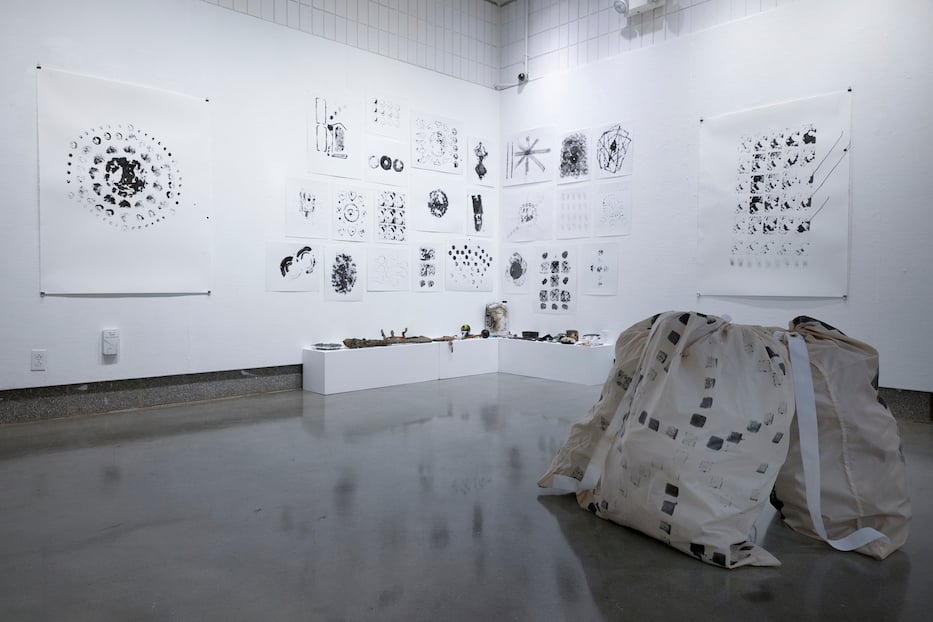
Installation view, To Dissolve into the Hydrocommons, One Drop at a Time. The exhibition, from New York based artist sTo Len, runs in the Seton Gallery at the at the University of New Haven through December 9. Photos by Jessica Smolinski courtesy of Seton Gallery.
From this collection, a serendipitous material culture emerged. A broken 45 RPM record, Chuck E. Cheese’s photo, panda mask, motor oil container, ladle, plastic and real crab, among others provide the basis for some of Len’s largest works on display. Soaked in sumi ink and stamped by hand, these repurposed materials were transferred onto canvas and pulp via a process the artist terms gomitaku (trash impression)—inspired by gyotaku (fish impression).
sTo created a taxonomy of monochrome shapes as orderly as a spreadsheet: ribbed foam containers, Push Pop tops, faux leather satchels seem gently seared onto these surfaces in soot.
Beneath an assemblage of single-item sketches, some of the refuse recycled to make these stamps are displayed at your ankles, as if excavated from an archeological site. A few steps away, more reminisce fills three sturdy sacks labeled Bags of Wharf (2022) emblazoned with silhouettes of their contents—symbolic of the burden we impose.
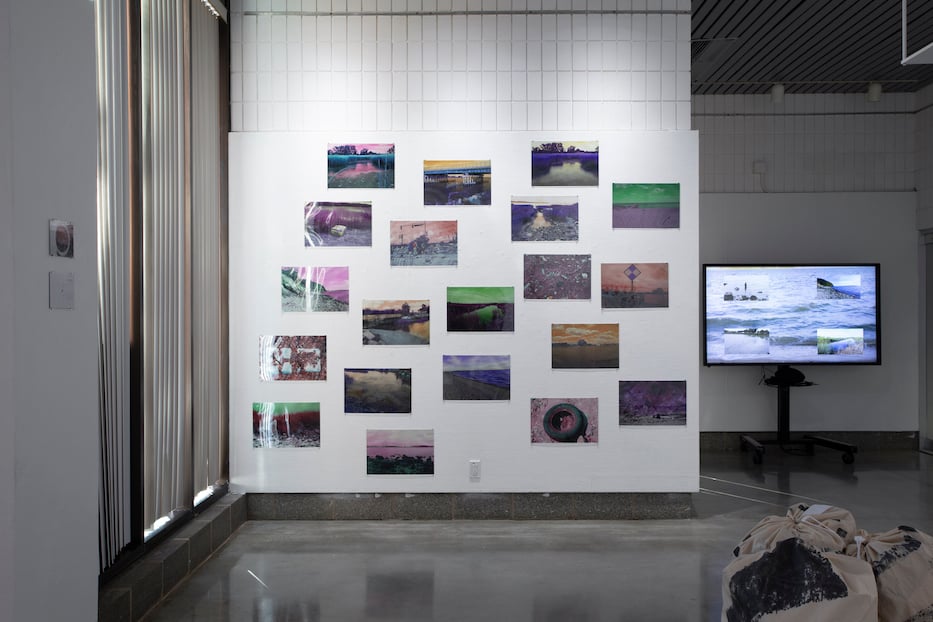
Installation view, To Dissolve into the Hydrocommons, One Drop at a Time. The exhibition, from New York based artist sTo Len, runs in the Seton Gallery at the at the University of New Haven through December 9. Photos by Jessica Smolinski courtesy of Seton Gallery.
A neighboring wall titled Waze of Seeing the Whirled (2022) depicts a constellation of photographs that shifts the narrative toward illustration. Seascapes with oil tanks in the distance, portraits of tidal waste, beachgoers floating on inner tubes are steeped in colors that render an opinion: the area is as radioactive as an Alice In Chains album cover from the 1990s. These are half-truths when compared to sTo’s other works on view.
“Mostly, I like to encourage stewardship and acknowledgement of the water bodies around as worth protecting,” said the artist.
Len’s work is a personalized cue that ecological care requires admission—we are complicit in the health of our own environment. If only this exhibition offered a charge deeper than awareness as a takeaway. Rethinking New Haven’s shoreline has already been on stakeholders’ minds, and an endeavor to reconnect residents and visitors to the waterfront is only building momentum.
The broader question here may be: are these renewal efforts meeting their intent?
When was the last time you took a walk along the Mill River Trail, watched migrations at Sandy Point Beach and Bird Sanctuary, fished off the pier at Long Wharf Park, or boated the Quinnipiac or West River?
And when you were there: what did you take away, and what did you leave behind?
Ronnie Rysz is an artist, designer, writer, and aspiring chef and cyclist.

